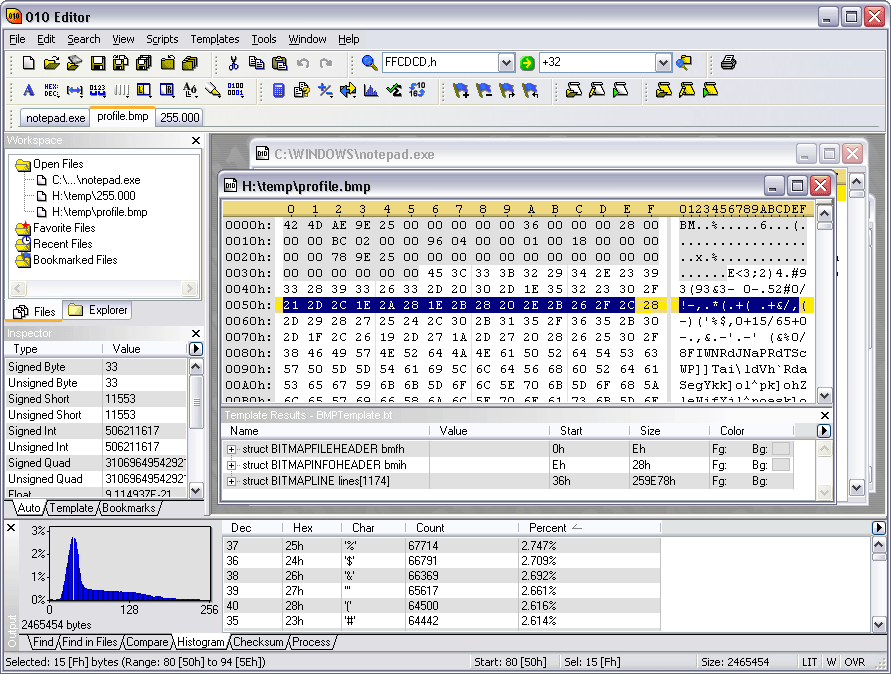

To control which Syntax Highlighter is applied when a new file is created see the Manage New File Types button in the Editor Options dialog. To control which Syntax Highlighters are run on load see the File Mask field of the Template Options dialog, accessed on the menu under ' Templates > View Installed Templates'. Syntax Highlighters can be set to run automatically when files are opened based on their extension or file name. Note the Syntax section is only shown when editing text files and the Status Bar will display 'Plain' if no Syntax Highlighter is active. To remove Syntax Highlighting from a file, click on the Syntax section of the Status Bar and select ' (none - plain)'. Syntax Highlighters can also be applied using the ' Templates > Syntax' menu. The easiest way to apply Syntax Highlighting is to click the Syntax section of the Status Bar at the bottom of the application as shown in the figure below. Syntax Highlighting allows applying colors to text in the Text Editor to make certain information easier to see. Installing Files on Open from the Repository.Using 010 Editor - Templates and Scripts.Typically these Templates should be denied but only grant permissions to read, write or execute if you understand what the Template is doing and why it needs special access.Ĭlicking the Reset button removes all Template Permissions and resets the Global Permissions to allow access. Click the Delete button to remove a permission or the up and down arrows to reorder permissions.Ī special warning is displayed when a Template that is installed from the public Repository asks for permission to read, write or execute other files.

By default, the permissions are set to Ask for ReadOther, WriteOther and ExecuteDLL but can be changed to Allow or Deny by clicking on a permission and using the drop-down list to select a new value. Additional permissions can be set by clicking the New button and choosing a Template in the standard file dialog box that is displayed. The Template Permissions table at the bottom of the Permission Options dialog displays any permissions that were allowed or denied for individual Templates. Clicking the Cancel button will stop Template execution. toggle in the Global Permissions section. Clicking Deny All when asking for permissions will turn on the corresponding Deny. If the operation is denied the Template will be stopped. Clicking Allow or Deny will create an entry in the Template Permissions table as explained below. When no permissions exist for a Template or the permissions are set to Ask and a Template attempts to read from or write to another file or execute a DLL function, a dialog box such as in the figure above will be displayed. If the Global Permissions are set to deny for read, write or execute, then the read, write or execute columns in the Template Permissions table are ignored. Read requests can be generated by using the FileOpen function and write requests can be generated by using any of the write functions or the FileSave function. Any permissions granted are displayed in the Template Permissions table below. If the deny read, write or execute Global Permission is turned off and a Template attempts to perform one of these operations, a dialog similar to below will be displayed to ask the user for permission. The Global Permissions toggles can be used to deny all Templates from reading other files, writing to other files, or executing functions in external DLLs. As well, Templates must be granted permission to call functions inside external dynamic link libraries as described in the External (DLL) Functions help topic. As one exception, a Template is allowed to create a new file with the FileNew function and write to that file without special permissions (using FPrintf for example), but to save the file to disk the Template must have write permissions.

Templates must be granted permission to read from or write to other files and these permissions can be controlled with the Permission Options dialog, as accessed by clicking ' Tools > Options.' on the menu and selecting Permissions from the list. Installing Files on Open from the RepositoryĪ Binary Template usually only reads data from one file at a time and cannot modify any files however, it is sometimes useful to have a Binary Template read from or write to another file (for example, if a dataset is split across multiple files or to write log files).


 0 kommentar(er)
0 kommentar(er)
